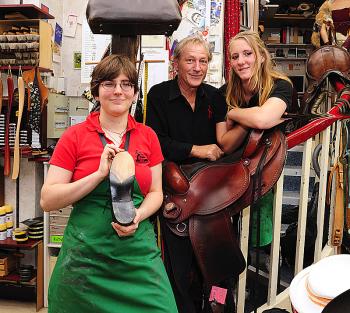The earliest shoemakers, also known as cobblers, arrived in Jamestown, Virginia in 1610. By 1616, shoemakers were found in many regions in America. In 1660, the Virginia Assembly mandated that every county have a tannery and a shoemaking factory.
The Williamsburg, Virginia website mentions that the Virginia Assembly “also imposed tariffs on leather and shoes exported from Virginia to control speculation and profiteering in the local shoe trade, and stipulated that the fees collected go to finance the founding of the College of William and Mary.”
Today, Williamsburg still sports a local shoemaker that trains apprentices. Tourists can visit here and also observe the process of how shoes are made.
The “Americans at Work” website publishes a list of American companies that make all types of shoes, from athletic shoes to cowboy boots, as well as shoes for children, women and men. The “Made in USA” label frequently appears on dancing, walking, hiking, riding and other kinds of shoes or boots.
There are many shoe production companies in the U.S. One company is Hampton Shoe & Repair. It has been in business since 1989 and offers over 250 different styles of American-made shoes. SAS is another, which opened its doors in the 1970s, and is still making handcrafted shoes. Loveless began operations 27 years ago, and produces shoes in a newly built factory. Its former factory had burned to the ground in 2004.
Art of Saddle Making Not Lost
The traditional saddle making profession has shifted gears and now also produces car upholstery, fine leather handbags and sporting gear. Making products from leather in Western countries has not disappeared, despite animal rights protection efforts. Many people, especially those from the upper class or those living in Europe and Asia would like to own at least one product made from leather, be it just a leather belt, one pair of shoes, or a little handbag.
There are still schools that teach saddle making, which can be found in the U.S., Australia, Canada and many other countries. The German city Hamburg alone lists a dozen artisan enterprises that manufacture custom-made shoes and around 20 custom saddle shops or upholsterers.
The Canadian company Okanagan Saddlery has been in business for nearly 50 years. It offers a three week-course that teaches its students how to make a saddle. In North Dakota, the Mike Heisler Company produces saddles and also teaches saddle making. The training commences in a shop that has all the equipment to make a saddle. The student receives one-on-one training.
Traditional training for a saddler includes being taught upholstery skills, interior floor surface applications, wallpapering and the making of window shades. Who knew?
These days, saddlers and shoemakers, having acquired traditional skills, can put them to use in repair work, restoration and creating new types of saddles. There are many different leather types that are used, not just cowhide: hides from horses, lambs, goats, pigs and deerskin, among others. The quality of the hide varies, and the items are often embellished with chains, rings, locks, studs and textiles.



